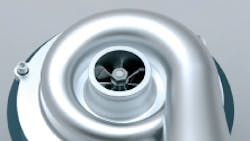Superchargers go electric
Electric superchargers have several advantages over turbochargers, including lack of turbo lag due to the electric superchargers switched reluctance motor with low inertia – it spins at up to 70,000 rpm in less than 350 milliseconds. They are also effective at low engine rpm, meaning engine size can be reduced but still deliver the same torque and horsepower. And when coupled to a gas engine in a hybrid system, electric superchargers provide a 20% saving on fuel and emissions.
These advantages are the main reason Valeo recently purchased the Variable Torque Enhancement business of Controlled Power Technologies, a British auto technology company. Valeo says the addition will give the French company a leg-up in terms of carbon-dioxide-reducing technologies.
Valeo’s new electric supercharger works with both Otto and Diesel engines, is designed to handle the standard 12-V vehicle electric system, and can be retrofit on new and existing vehicles. It works in temperatures from -40 to 125 degrees C, draws 350 A when it is used for acceleration, 220A when operating in steady state, and only 1.5 A when the engine idles.
When electric supercharging was tested on a 1.6-liter Otto engine, torque rose by 40% with no carbon dioxide increase. And 0 to 100 kph times went from 13 to 10.9 sec, a 17% improvement. Researchers also put the electric supercharger on a 1.4-liter engine, which gave it the performance of a 1.6 liter engine but with less fuel consumption (6.4 liters per 100 km instead of 7.3-litters per 100 km).
